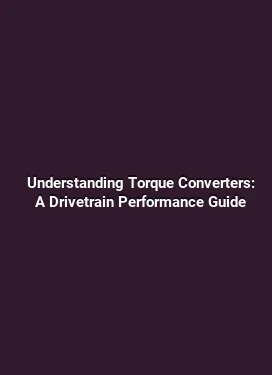How to Rebuild Manual Transmission for High Performance Use
A high‑performance manual transmission rebuilt with precision can unlock smoother shifts, improved power transfer, and enhanced durability under demanding driving conditions. This guide provides a practical, experiment‑driven approach that covers planning, disassembly, inspection, upgrade options, reassembly, and testing. It emphasizes real‑world applications, from drag racing to track days, and explains how each decision affects reliability, weight, and efficiency.
Understanding the Fundamentals of Manual Transmissions

Manual gearboxes transmit torque through gears, shafts, bearings, synchronizers, and shift mechanisms that must operate in harmony. The core objective in a high‑performance rebuild is to preserve strength under elevated loads while reducing friction and optimizing gear engagement. A solid understanding of gear ratios, gear geometry, and bearing preload helps in selecting the right components for specific performance goals, whether that be quicker 1–2 shifts, higher top speed, or improved endurance in endurance events.
From a mechanical standpoint, the main parts to examine are the mainshaft, countershaft, cluster gear set, differential ring gear, input shaft, output shaft, and the housing’s oiling passages. Proper lubrication is essential, especially under high rpm and sustained load. Oil viscosity, film thickness, and pan flow influence both wear and cooling. When rebuilding, evaluating oil channels, pickup depth, and scavenge capacity prevents oil starvation during aggressive shifts or prolonged high‑rpm operation.
Planning a High-Performance Rebuild
The planning phase defines the project scope and sets budgetary expectations. Start with a clear set of performance targets—desired gear ratios, torque capacity, shift feel, and weight considerations. Gather data on the vehicle’s engine characteristics, tire grip, and track conditions to align the transmission changes with real driving scenarios. A well‑documented plan prevents feature creep and ensures each upgrade contributes tangible benefits.
Before any disassembly, inventory the current components, measure critical clearances, and identify failing parts. Common failure modes in high‑output applications include worn synchronizers, chipped gears, misaligned shafts, and degraded bearings. Creating a parts plan that prioritizes high‑impact upgrades—such as stronger gear sets, improved synchronizers, or a more robust input and main shaft—helps manage cost while delivering meaningful performance gains.
Disassembly and Inspection Strategy
Disassembly begins with securing the transmission and draining oil to inspect the internal state. Label every part’s position to simplify reassembly and avoid mix‑ups with identical components from different gear ranges. When removing the cases, inspect for cracks, corrosion, and oil contamination. Look closely at the mainshaft and countershaft for scoring, pitting, or bending. Bearing seats should be checked for wear and misalignment, as degraded seats can cause chatter or uneven load distribution during operation.
Gear contact patterns reveal a lot about surface finish and load distribution. Use a bright light and feeler gauges or a borescope to assess gear backlash, tooth wear, and the presence of micro‑cracks. Synchronizer sleeves should slide smoothly along the gear teeth, with uniform engagement force. If a synchronizer shows glazing, stuck collars, or missing springs, plan for replacement. Lubrication passages must be free of obstructions; any restriction can lead to hot spots and accelerated wear during hard use.
Gear Set Upgrades and Synchronizer Upgrades

One of the most impactful areas for a high‑performance rebuild is the gear set. Stronger, stiffer gears with precise tooth profiles reduce flex under load and improve shift consistency. When selecting a gear set, consider material grade (commonly high‑grade alloy steels), heat treatment (case hardening or surface hardening), and manufacturing tolerances. A properly matched gear set reduces noise and improves reliability at high rpm while providing the required gear ratios for the intended application.
Synchronizer upgrades can dramatically improve shift quality under load. Modern performance synchronizers use advanced alloys and slipper designs to minimize friction and wear during engagement. If the vehicle sees aggressive operation or frequent downshifts under high torque, upgrading synchronizers minimizes gear clash and extends life. It is essential to verify that the synchro sleeves, hubs, and springs are compatible with the chosen gear set to avoid mis‑engagement or premature wear.
Bearings, Shafts, and Alignment
Bearings must accommodate higher loads without overheating. Upgrading to larger or more robust bearings can reduce parasitic drag while increasing durability. Pay attention to bearing preload; improper preload can cause premature wear or noise. When replacing shafts, ensure they have sufficient torsional stiffness and precise diameters to maintain correct mesh alignment with the countershaft gears. Alignment jigs and dial indicators help confirm that the shafts sit square within the housing, preventing binding and unwanted shaft walk during operation.
Reassembly and Tuning
Reassembly should proceed in a deliberate, methodical order. Start with the mainshaft and countershaft assembly, then install the bearings, spacers, and synchronizers before seating gears. Use appropriate assembly lubricants and avoid dry fits on critical surfaces. Torque specs for fasteners must be followed exactly; under‑ or over‑torquing can warp the housing, alter preload, and compromise seal integrity. Cleanliness is non‑negotiable—tiny metal shavings or dust can become abrasive once the transmission is pressurized with oil.
After the assembly is complete, perform a pre‑fill with oil to check for binding before mounting the case halves. When the case is closed, verify that the shift mechanism moves with consistent feel across all gears. A progressive, linear shift feel usually indicates correct alignment and proper load distribution. If the shifts feel gritty or inconsistent, recheck the synchronizer clearance, gear mesh, and bearing seating before proceeding to the testing phase.
Lubrication Strategy for High RPM and Heat Management
Lubrication plays a crucial role in high‑performance operation. Selecting the right viscosity at operating temperature ensures a stable lubricating film and minimizes wear. Consider gear oil with friction modifiers that suit your synchronizer design while staying within the housing’s heat management limits. If track conditions demand sustained high rpm, evaluate a gear oil with superior shear stability and better oxidation resistance. Oil volume and cooling are equally important—adequate pan capacity and/oil cooling features help maintain stable temperatures during repeated launches or long stints on track days.
Testing and Break‑In Procedures
Testing begins with static checks: verify gear engagement with the engine off, ensure there are no leaks, and measure oil pressures at startup. A cautious initial test drive at light throttle lets the system reach operating temperature while allowing you to monitor for unusual noises, vibration, or binding. Gradually increase load and rpm, paying attention to shift quality, synchronizer engagement, and any heat buildup in the transmission housing.
Break‑in procedures vary by gear set and material, but a common approach emphasizes gentle power ramping and avoiding aggressive shifts during the initial miles. Track testing should be conducted with data logging if possible, recording engine torque, shift times, and temperatures. If a shift feels sluggish or a gear grinds, do not push past that point; inspect the related components and confirm clearances and alignment before continuing. The goal of break‑in is to seat surfaces, verify lubrication paths, and confirm that all upgrades perform reliably under real driving loads.
Common Pitfalls and Troubleshooting
Several issues are frequently encountered in performance rebuilds. Common symptoms include gear mis‑engagement, sudden shifts, or faint grinding noises. These often point to misalignment of gears, incorrect shimming, or worn synchronizers. Another frequent cause is oil starvation due to blocked passages or inadequate pan baffling; this can lead to bearing wear and early failure. If hot spots or abnormal heat rise appear during testing, reassess lubrication routing, material choice, and the overall cooling strategy for the transmission housing.
Noise and vibration require careful diagnosis. Excessive gear whine can indicate improper backlash or tooth geometry, while a rumble at certain RPM ranges could imply bearing issues or housing distortion. A methodical approach—checking backlash, confirming gear tooth contact patterns, and verifying case rigidity—helps isolate the root cause and prevent unnecessary part replacement.
Maintenance and Longevity
Even after a successful rebuild, ongoing maintenance is key to longevity under high performance use. Regular oil changes with the correct specification help remove contaminants that can accelerate wear. Monitor oil temperature and ensure the cooling system remains effective, especially in hot climates or during long sessions. Inspect for leaks, cracks, and seal integrity during routine service. Periodic inspection of synchronizers, bearings, and gear surfaces keeps the system running smoothly and reduces the likelihood of unexpected failures during competition or spirited road use.
Record keeping is a simple but powerful practice. Maintain a log of part numbers, gear ratios selected, torque values used, and observed performance characteristics. This data supports future upgrades, troubleshooting, and ensures that any iteration stays aligned with your performance goals. By combining careful planning, meticulous assembly, and disciplined testing, a manual transmission rebuild can deliver reliable performance gains across a broad range of driving scenarios.






